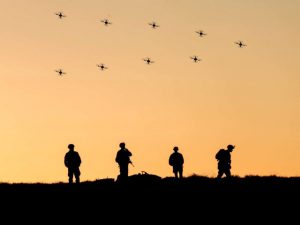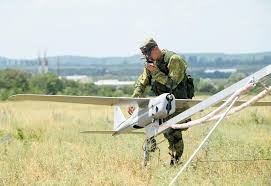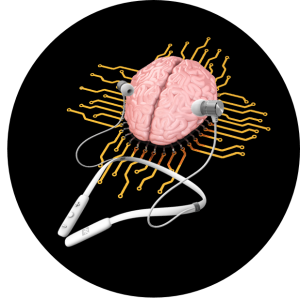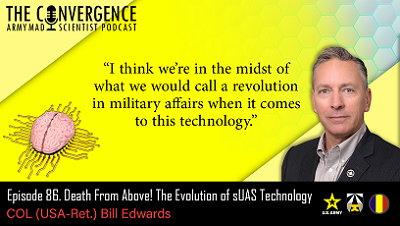“I think we’re in the midst of what we would call a revolution in military affairs when it comes to this technology.”
[Editor’s Note: Army Mad Scientist continues to explore issues impacting the Operational Environment, especially those directly affecting U.S. Army operations in the contemporary battlespace. Over the past decade-plus, dual use automation technologies have increasingly been weaponized by state and non-state actors alike, democratizing warfighting capabilities in the air, land, and sea domains. In the air domain, Uncrewed Aerial Systems (UAS) initially provided Intelligence, Surveillance, and Reconnaissance (ISR) capabilities without the associated costs and infrastructure required to operate manned platforms. More recently, we’ve witnessed ISR and strike capabilities converge in small UAS (sUAS), granting lesser powers the ability to identify, reach, and strike targets — “lower[ing] the ‘entry fee’ into combined arms operations.”
With this democratization of the air domain, we’re also witnessing the resurgence of Mass. Virtually anyone will “be able to use these small, cheap, and individually expendable platforms to almost continuously gather real-time intelligence and choose the time and place to overwhelm an adversary’s defenses through sheer volume” — creating, in the eloquent words of proclaimed Mad Scientist Zachery Tyson Brown, Jomini’s Revenge: Mass Strikes Back!
Today’s episode of The Convergence podcast features our interview with COL Bill Edwards (USA-Ret.) exploring the very real, contemporary threat presented by sUAS, what trends he’s seeing emerge from current and recent conflicts, and how the U.S. Army, the Joint Force, and the Nation as a whole should respond. Read the highlights from our interview below, then listen to this important podcast — it’s not too late, but the time to act is now!]
[If the podcast dashboard is not rendering correctly for you, please click here to listen to the podcast.]
 COL Bill Edwards (USA-Ret.) currently serves as President of Federal and Public Safety at Building Intelligence, Inc. Before this role, COL Edwards was a Principal in Protective Design and Security for Thornton Tomasetti, a globally recognized structural engineering firm. As an organizational leader, he has been instrumental in expanding the organization’s global footprint by providing strategic direction in the startup of a new security consultancy division focused on providing comprehensive security-driven risk mitigation approaches and business continuity solutions.
COL Bill Edwards (USA-Ret.) currently serves as President of Federal and Public Safety at Building Intelligence, Inc. Before this role, COL Edwards was a Principal in Protective Design and Security for Thornton Tomasetti, a globally recognized structural engineering firm. As an organizational leader, he has been instrumental in expanding the organization’s global footprint by providing strategic direction in the startup of a new security consultancy division focused on providing comprehensive security-driven risk mitigation approaches and business continuity solutions.
Before this, COL Edwards served as the Director of Intelligence, Special Operations Command North, where he oversaw the successful unification of interagency communications in support of Homeland Defense. He additionally earned recognition for transforming a struggling $400M DoD technical intelligence program as the Capability Director for the U.S. Army’s Intelligence Center, and served as a Commander in the U.S. Army, overseeing strategic military and intelligence operations in theatres across the globe.
From 2009 to 2011, COL Edwards served as a Commander and Director of Operations during Operation Iraqi Freedom and Operation New Dawn. In this highly complex leadership role, he led a U.S. Army Battalion of 800 personnel, a $50M operating and contract budget, and numerous governances, economic development, and security readiness programs. He additionally managed two major U.S. Base facilities, as well as numerous outposts, located throughout a geographic region the size if the State of Kentucky. Lastly, he led the Brigade’s Counter Improvised Explosive Device (IED) network defeat operations.
COL Edwards co-authored Inside Abu Ghraib: Memoirs of Two U.S. Military Intelligence Officers, and is an editorial writer for Forbes, ASIS International, Security Industry Association (SIA), and Security Magazine. He is routinely invited to speak at nationally attended security industry symposiums. He holds two Master’s Degrees in National Security and Public Administration and most recently attended Harvard’s Executive Negotiations and Duke University’s Executive Leadership programs. COL Edwards has also created three adult learning classes to support education surrounding the small Uncrewed Aerial System (sUAS) technology — The Evolution of Drones in Society and Conflict — found at: www.phoenix6consulting.com. Based on his strengths as a contextual leader, COL Edwards has proven his ability to serve as an agent of change by identifying and resolving enterprise-level issues, creating identity, and harnessing the “power of the team”. He has extensive experience in high-profile security projects in a myriad of markets.
Army Mad Scientist sat down with COL Edwards to discuss the contemporary threat presented by sUAS, what trends he’s seeing emerge from current and recent conflicts, and how the U.S. Army, the Joint Force, and the Nation as a whole should respond. The following bullet points highlight key insights from our conversation:
-
-
- Advancements in sUAS technology are changing modern conflict — creating a Revolution in Military Affairs — making the air domain an integral part of comprehensive security program development. As the
 convergence of Artificial Intelligence (AI) and autonomous systems matures into new technology, our training models at every level must teach our Soldiers how to fight and win in this environment and Leaders how to recognize and defend against the threat these capabilities represent to their units and missions.
convergence of Artificial Intelligence (AI) and autonomous systems matures into new technology, our training models at every level must teach our Soldiers how to fight and win in this environment and Leaders how to recognize and defend against the threat these capabilities represent to their units and missions.
- Advancements in sUAS technology are changing modern conflict — creating a Revolution in Military Affairs — making the air domain an integral part of comprehensive security program development. As the
-
-
-
- The Russia/Ukraine conflict is the latest laboratory for the evolution of sUAS platforms, especially with the evolution of First-Person View (FPV) drone technology –
 using virtual reality to fly a drone with strike precision into a target. The evolution of sUAS technology can be traced to the Israel/Hamas conflict in 2021, the Nagorno-Karabakh conflict in 2020, the initial Russia/Ukraine conflict in 2014, and as far back as Iraq in 2010.
using virtual reality to fly a drone with strike precision into a target. The evolution of sUAS technology can be traced to the Israel/Hamas conflict in 2021, the Nagorno-Karabakh conflict in 2020, the initial Russia/Ukraine conflict in 2014, and as far back as Iraq in 2010.
- The Russia/Ukraine conflict is the latest laboratory for the evolution of sUAS platforms, especially with the evolution of First-Person View (FPV) drone technology –
-
-
-
- Drone usage in the Russia/Ukraine conflict is different than any other recent modern conflict – commanders today are facing an entirely new
 set of challenges. In 2010, enemy forces started to develop sUAS technology solely for intelligence, surveillance, and reconnaissance (ISR) capabilities. In the contemporary battlespace, ISR and weapons delivery capabilities have converged in Category 1-3 drones.
set of challenges. In 2010, enemy forces started to develop sUAS technology solely for intelligence, surveillance, and reconnaissance (ISR) capabilities. In the contemporary battlespace, ISR and weapons delivery capabilities have converged in Category 1-3 drones.
- Drone usage in the Russia/Ukraine conflict is different than any other recent modern conflict – commanders today are facing an entirely new
-
-
-
- Drone and sUAS platforms can be extremely cheap, making them easily accessible to smaller nations, governments, and organizations. In recent conflicts, governments have also urged private citizens to
 offer their drones to assist with ISR capabilities. The advancement of 3-D printing is another mechanism heavily relied on throughout the Russia/Ukraine conflict for creating launch-and-forget drone platforms that can carry a payload.
offer their drones to assist with ISR capabilities. The advancement of 3-D printing is another mechanism heavily relied on throughout the Russia/Ukraine conflict for creating launch-and-forget drone platforms that can carry a payload.
- Drone and sUAS platforms can be extremely cheap, making them easily accessible to smaller nations, governments, and organizations. In recent conflicts, governments have also urged private citizens to
-
-
-
- With further blurred lines between military and civilian targets, there will be no rear area in future conflicts. Critical infrastructure in a
 conflict zone requires a layered, integrated defense for the air domain (not just air defense, but organic Counter-UAS, across all echelons and spanning the entire battlespace, from the forward edge of battle, Rear and Staging Areas, Air and Sea Ports of Embarkation/ Debarkation, all the way back to the garrison). Protecting critical infrastructure is also a top priority for the private sector.
conflict zone requires a layered, integrated defense for the air domain (not just air defense, but organic Counter-UAS, across all echelons and spanning the entire battlespace, from the forward edge of battle, Rear and Staging Areas, Air and Sea Ports of Embarkation/ Debarkation, all the way back to the garrison). Protecting critical infrastructure is also a top priority for the private sector.
- With further blurred lines between military and civilian targets, there will be no rear area in future conflicts. Critical infrastructure in a
-

Stay tuned to the Mad Scientist Laboratory for our next episode of The Convergence podcast on 26 October 2023, when we report back from “Fight Night” in Washington, D.C. — a night of wargaming and wargamers — and talk with the Hon. Mac Thornberry about the importance of wargaming to public policy, his experiences with it on the Hill, and what we can do to better emphasize it with our lawmakers!
If you enjoyed this post, check out how China, our pacing challenge, is thinking about employing UAS:
The PLA and UAVs – Automating the Battlefield and Enhancing Training
A Chinese Perspective on Future Urban Unmanned Operations
China: “New Concepts” in Unmanned Combat and Cyber and Electronic Warfare
The PLA: Close Combat in the Information Age and the “Blade of Victory”
… as well as the following related Army Mad Scientist content:
Unmanned Capabilities in Today’s Battlespace
Insights from the Robotics and Autonomy Series of Virtual Events, as well as all of the associated webinar content (presenter biographies, slide decks, and notes) and associated videos
Insights from Ukraine on the Operational Environment and the Changing Character of Warfare
Turkey and the TB-2: A Rising Drone Superpower and its associated podcast, with Karen Kaya
The Dawn of the Loitering Munitions Era, by proclaimed Mad Scientist SGM Daniel S. Nasereddine
Top Attack: Lessons Learned from the Second Nagorno-Karabakh War and its associated podcast, as well as Sooner Than We Think: Command Post Survivability and Future Threats and its associated podcast, both with COL John Antal (USA-Ret.)
Insights from the Nagorno-Karabakh Conflict in 2020 (Part I and II)
“Once More unto The Breach Dear Friends”: From English Longbows to Azerbaijani Drones, Army Modernization STILL Means More than Materiel, by Ian Sullivan.
Jomini’s Revenge: Mass Strikes Back! by proclaimed Mad Scientist Zachery Tyson Brown
How Big of a Deal are Drone Swarms?, A New Age of Terror: The Future of CBRN Terrorism, and A New Age of Terror: New Mass Casualty Terrorism Threats, by proclaimed Mad Scientist Zachary Kallenborn
Through Soldiers’ Eyes: The Future of Ground Combat and its associated podcast
The Future of Ground Warfare and its associated podcast, with proclaimed Mad Scientist COL Scott Shaw
Ground Warfare in 2050: How It Might Look, The Intelligent Battlefield of the Future, and its associated podcast with proclaimed Mad Scientist Dr. Alexander Kott
Disclaimer: The views expressed in this blog post do not necessarily reflect those of the U.S. Department of Defense, Department of the Army, Army Futures Command (AFC), or Training and Doctrine Command (TRADOC).
.



